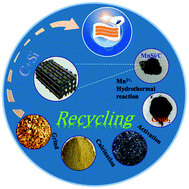Rice husk-derived Mn3O4/manganese silicate/C nanostructured composites for high-performance hybrid supercapacitors†
Abstract
Rice husks (RHs) rich in carbon and silicon elements are one of the worldwide abundant agricultural residues, and they can be a useful source of active materials for energy storage. However, most of the previous research studies concentrated on the use of one of the elements such as carbon or silicon. In order to fully recycle RHs, here, we report a novel hydrothermal process to develop Mn3O4/manganese silicate/C nanostructured composites using RHs as the raw materials. The as-prepared materials possess well- developed porosity with a high specific surface area because of the biomass-derived carbon. The unique structure endows the nanocomposite with desired electrolyte wettability and fast absorbance/desorbance for electrolyte ions. The active materials exhibit excellent performance, with a good capacitance of 108 F g−1 at 1 A g−1 as well as excellent cycling behavior with a retention of 82% after 8400 cycles as a supercapacitor electrode. In addition, the flexible solid-state hybrid supercapacitor (c-MnSi-2//Ni(OH)2) thus derived realizes a maximum energy density of 13.3 W h kg−1 at the corresponding power density of 103.9 W kg−1 and a capacity retention of 81% after 5000 cycles.



 Please wait while we load your content...
Please wait while we load your content...